Bernina sewing machines are the Lamborghinis of the sewing world. But even high-end machines need repairs or professional servicing once in a while! You can DIY repairs with a Bernina sewing machine repair and troubleshooting guide.
Bernina sewing machine repair sometimes involves adjusting the upper tension or moving the needle bar. Many models also need regular oiling and thorough cleaning to remove thread fragments. Troubleshooting bobbin and wiring issues can also repair some common Bernina errors.
In this article, you will learn how to repair twelve common Bernina sewing machine issues. You will also discover how to find a certified Bernina repair shop near you. Finally, you will find tips for locating Bernina parts and repair manuals.
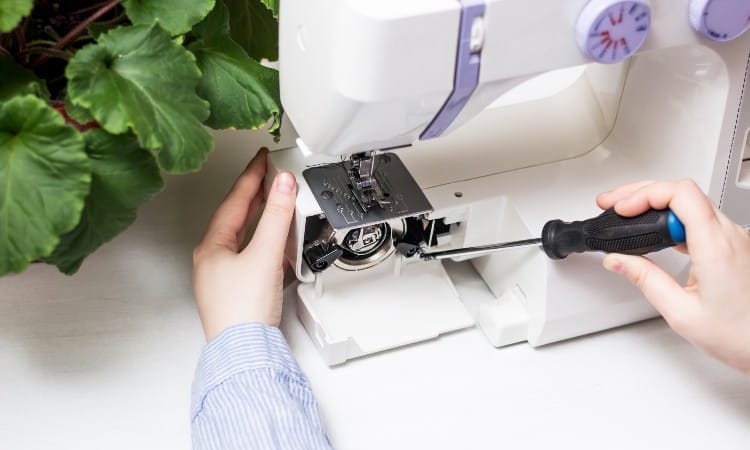
What to Know About Bernina Sewing Machines
Bernina sewing machines have a special reputation in the sewing community. Often considered the premier high-end machines on the market, they come with all kinds of advanced technology and sometimes astronomical price tags. The Bernina company has a history stretching back to the mid-1800s and has remained family-led up to the modern day!
Ever since its founding in 1863, Bernina has developed innovative sewing technology. Over the years, Bernina’s inventions include the first knee-activated presser foot lifter and the first portable zig-zag sewing machine. Much later on, when Bernina introduced its revolutionary 830 models, the company had to file 15 patents to cover all the new technology used in this machine!
Bernina is famous for its precise craftsmanship besides challenging the status quo of sewing technology. Most modern sewing machines today use cheap plastic parts inside, but high-end Bernina models continue to use a significant amount of more durable metal to prolong the lifespan of these machines.
In short, many sewers love Bernina sewing machines because these models offer advanced technology, reliable craftsmanship, and durable parts! The only real downside to Bernina sewing machines is their cost. The company does offer a line of economy models better suited to the beginning sewer, starting at around $200, but high-end models can cost as much as $25,000 brand new!
Today, Bernina International AG still operates out of the company’s historic Swiss location, but most manufacturing takes place overseas in Southeast Asia. Vintage Bernina models still command a high price because these older models were actually made in Switzerland at the original Bernina facility.
Troubleshooting Bernina Sewing Machines: 12 Common Problems
All sewing machines need maintenance and occasional repairs. Most of the time, what may seem like a disaster or a jammed machine may just need a simple rethreading or removal of thread fragments to get your machine purring along once more!
But even Lamborghinis need regular tune-ups and sometimes break down. This holds true for fancy sewing machines, too! Even Bernina machines will sometimes encounter real issues. Depending on your confidence level, you may feel able to handle adjusting a needle bar position or replacing a drive belt.
If not, the good news is that it’s pretty easy to find a local Bernina dealer to help you out! You may need to take your machine to a professional because Bernina machines often come with warranties that guarantee you support from your local Bernina dealer. If you have a newer machine, you should always check your warranty terms before attempting to repair yourself, as you could accidentally void the warranty.
But you should master a few simple fixes yourself or you will find yourself frustrated as you try to use your fancy Bernina sewing machine! Learning a few simple troubleshooting techniques will let you settle into a fun, peaceful sewing experience without worrying about a broken needle or tangled thread.
1. Where to Start
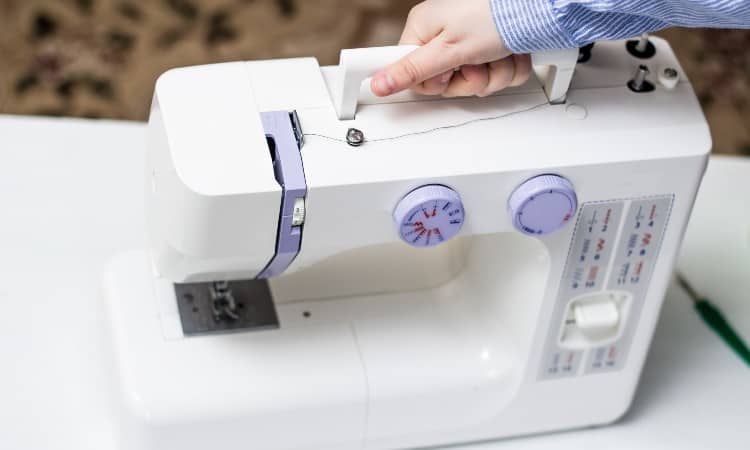
Sometimes it doesn’t hurt to state the obvious: before diving into complex repairs. You should try turning off and rethreading your sewing machine! Even experienced sewers often encounter an upper thread that slipped free of the thread path and caused a tangle somewhere. Plus, many tension problems stem from incorrect threading.
Do yourself a favor and develop a quick routine of turning off, rethreading, and turning back on before you panic about possible serious problems in your machine.
If you don’t already do this, you should also get in the habit of cleaning your machine regularly. One of the problems with a machine containing precisely fitted parts like a Bernina is that even a speck of loose thread caught in the wrong place can create a big problem. Regular cleaning will help prevent this.
If you do run into an issue like a jam, you should rethread and then add a good cleaning on top of that before turning your machine back on to see if that will fix the issue.
If you always start with rethreading and cleaning, you will save yourself a lot of time and maybe even a lot of money by avoiding taking your machine in for unnecessary repairs!
2. Machine Won’t Turn On
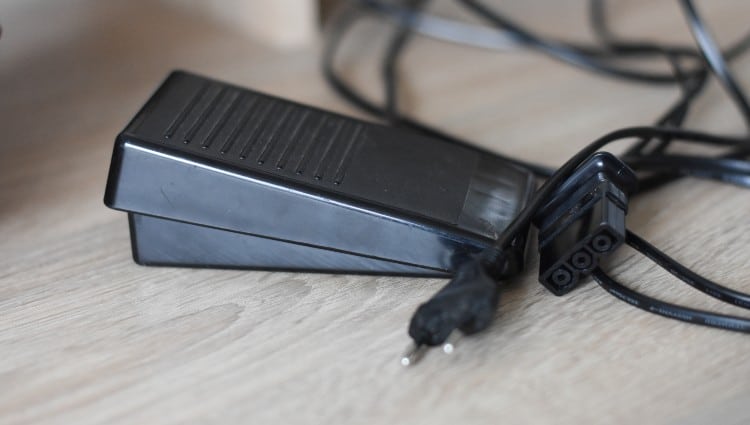
While it’s possible that something has gone disastrously wrong inside your machine, you should go through this basic checklist of options before giving up when your machine won’t turn on!
- Check the power connections. This includes the wall outlet, the connection to the machine, and the pedal plug! Maybe you moved your machine around to make space for the bulky quilt you had to fit on your sewing table, and that jostled a cord-free. It doesn’t hurt to take a quick moment and check on the basics!
- Try using a different electrical outlet. You could have a fuse issue going on in your house or workspace! You can check the outlet by plugging in something else like a lamp or clock to see if that turns on.
- Try turning off the power switch. Wait for two to three minutes, and then turn the machine back on. This “fix” sometimes works on older models.
- Some sewing machines may not work when a lightbulb has burned out, Try replacing the sewing light bulb and then turn the machine on again.
- Does the sewing light come on when you turn on your machine? If the light comes on, but the rest of the machine does not, you may have an internal issue that requires professional care.
3. Handwheel Can’t Turn
When your handwheel can’t turn, the needle bar also can’t rise and fall, and you’re stuck! Sometimes this issue has an accompanying grinding noise that does sound scary. Don’t panic, though, because this issue often has easy solutions.
- Sometimes the handwheel gets jammed because of tension problems that created a “bird’s nest” tangle beneath the fabric. In this case, begin by carefully cutting away the tangle and thoroughly cleaning bits of thread out of the bobbin case before rethreading the machine. Turn the machine back on and try turning the handwheel to see if this corrected the issue!
- Some older Bernina models may need oiling to keep everything connected to the handwheel spinning smoothly. Before applying oil, please refer to your sewing machine manual, as many newer models do not need oiling!
- If you have tried all the easy fixes above, it’s possible that the belt inside your machine snapped or eroded, especially if you have an old model that has seen heavy use. In this case, you may want to consider professional servicing.
4. Machine Won’t Sew
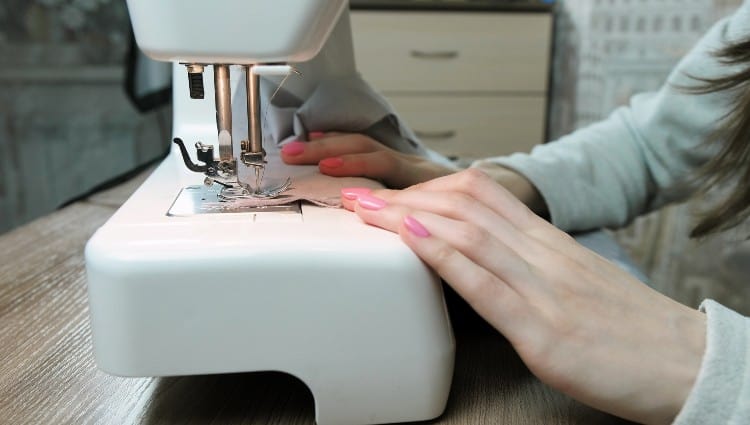
If your machine turns on but will not sew, try going through this handy checklist to see if you can solve the problem yourself!
- As always, turn the machine off and rethread as a first step! Possibly a thread snuck free of the tension discs and jammed things up. It takes less than thirty seconds to rethread your machine, so try that first to see if you can bypass the more complicated procedures!
- Check the settings on your machine, especially if you have a computerized model capable of many different functions. You may need to reset the stitch length, stitch pattern, or other functions to return to basic sewing.
- Did you just wind a bobbin? On some Bernina models, the bobbin winding features prevents the machine from sewing. If you have one on your machine, you need to return the settings to the stitching pattern you want and disengage the bobbin winder.
- Likewise, some Bernina models have sensors inside the little door that seals off the bobbin area. Make sure that it is closed properly, as it could prevent the machine from sewing if it stayed open!
- A bent needle will also prevent your machine from sewing. Switching out different attachments such as a zigzag foot or a buttonholer may have caused your needle to strike metal, bending it, so it no longer makes a straight vertical line. Your machine often will not sew when a bent needle lands on the feed dogs or somewhere else it shouldn’t touch!
5. Will Only Sew in Reverse
OK, you probably won’t come across a Bernina machine that will only sew in reverse that often! But when you do, you will need to know how to troubleshoot this weird situation.
Many models have a simple button or lever you press to activate sewing in reverse. Sometimes this button can get stuck, meaning that your machine will only sew backward.
For most models, old or new, you will have to open up the machine’s casing to get inside the head. You may need to take out a circuit board to reach the reverse lever, too.
That said, if you feel brave enough to poke around inside your sewing machine, you may simply need to apply a bit of sewing machine oil to the interior portion of the reverse lever!
If that doesn’t work, you probably do need to take your machine to an expert.
6. Needle Keeps Breaking
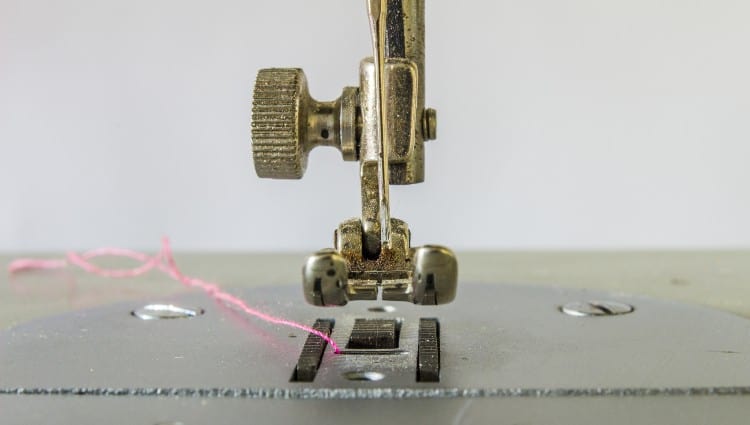
Once in a while, needles do break while you sew–you may have found an odd needle with a defect in it, for example! But if your needles keep breaking, something is up.
Broken needles can have multiple different root causes.
- Bernina recommends only using certain high-end brands of needles and thread with its machines. Now, we all like to save a few pennies here and there, but it is true that generic, cheap needles may not fit your machine correctly, causing them to break repeatedly.
- Aside from the question of quality needles, the most common reason for a needle to break is that the needle bent over time, perhaps from striking sewing pins, and then eventually got so crooked that it came down hard on the needle plate or feed dogs! To prevent this, regularly replace your needle with a new one as you sew.
- Another common cause for broken needles is too-thick material. Make sure you match the type of needle with the kind of fabric and thread you choose for your project.
- Along a similar vein, use the correct needle for the various attachments and functions you may need! You don’t want to accidentally use a zigzag stitch on top of a ruffle presser foot, for example!
- Try not to sew over zippers, buttons, or sewing pins. You know this, of course, but when you’re in a hurry, you may forget to keep an eye out for these obstructions!
7. Thread Keeps Breaking
Broken thread while sewing interrupts the flow of your work and gets annoying fast! Unfortunately, this common issue can have many different causes. Try this checklist of possible solutions to see if you can troubleshoot the issue!
- It never hurts to try rethreading everything, just in case!
- Check the needle to see if you spot any scratches or dings. The thread might catch on to the defects, causing it to fray.
- Look up the needle size and thread type and make sure they pair together well. A too-thick thread may keep fraying and breaking as it goes through the eye of a too-small needle.
- Another common possibility is that the upper tension could keep the top thread pulled too tightly, putting so much strain on it that it repeatedly snaps. In this case, you need to adjust the upper tension to a lower setting, easing the pressure on the top thread.
- You may need to rewind your bobbin, especially if you see odd loops or spikes of thread coming off the spool!
- If you like vintage things, you may want to sew with authentic vintage thread. Please don’t! This thread looks pretty on the spool, but the old thread will snap and break constantly and will create weak seams, to boot!
- If you have your machine set to a fancy embroidery pattern, make sure you have not sued any zero-length stitches! Sometimes you can inadvertently use a touch screen or LCD panel to set regular sewing stitches to zero-length, as well. So check your settings to see if this will prevent the thread from snapping!
8. Bobbin Winder Won’t Work
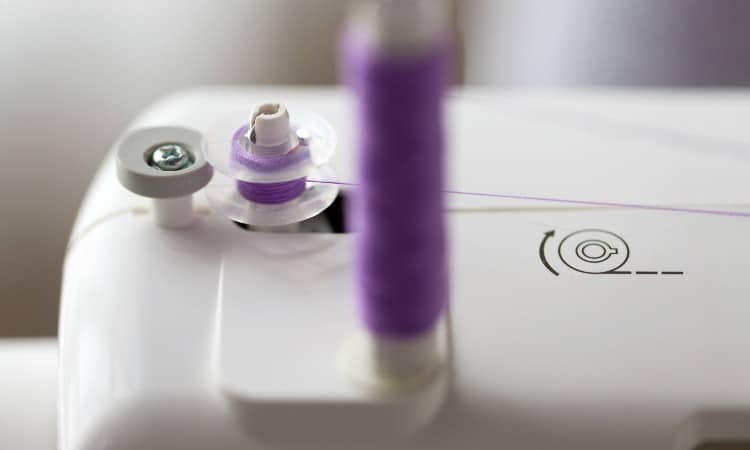
Typically, you can check three possible causes for a bobbin winder that won’t work.
- Make sure you have not gathered up a lot of loose thread around the pin of the winder! Sometimes thread wraps itself around the pin instead of the bobbin if you didn’t securely insert the bobbin or the thread as you began the process. In this case, simply remove the thread and start over!
- Some Bernina bobbin winders have a small pad or rubber discs beneath where the bobbin rests. This may have cracked or grown old, so try replacing it to see if that corrects the problem.
- Finally, some older models, especially vintage models from before the 1970s, may need regular oiling. Read your manual carefully to determine if the bobbin widener needs sewing machine oil, and then try lubricating with just a few drops!
9. Hook Problems
If something goes wrong with the hook system, your sewing machine may stop making stitches at all, or you might see stitching problems like skipped stitches. Most new, computerized Bernina machines will give you an error code or message to indicate a problem with the hook.
What is a hook? Every sewing machine has a tiny, crucial moving part called a hook that catches the thread after passing through the needle. Basically, the hook system is what allows the upper and lower thread to catch, creating stitches!
The easiest DIY fix for this kind of error is to carefully clean the bobbin area. Look at it through a magnifying glass if you need to, but make sure no lint or thread lingers when you’re done! A tiny scrap of loose thread can often insert itself somewhere in the hook system and jam everything up.
Some Bernina models have a hook race that needs oiling or a small reservoir of oil in this area that may need refilling.
You may also need to adjust the tension on the bobbin case or clear debris away from the sensor on the bobbin door.
Finally, sometimes the hook timing gets thrown off. This is a more complex problem that usually requires professional intervention.
10. Tension Trouble
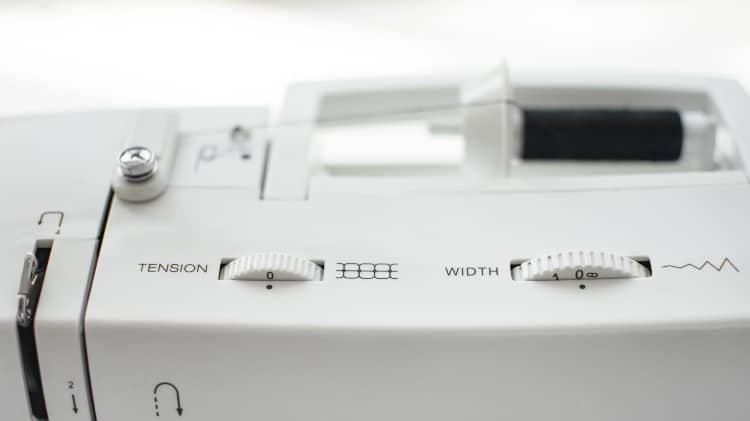
Sewing machine tension settings can cause trouble even for experienced sewers, largely because every different kind of fabric or type of sewing may need a unique tension setting!
How can you find that correct tension for each new project and get stitching that looks the same on the front and back of the fabric? Follow these seven steps!
- Do a quick cleaning of your machine, paying special attention to removing any lint from beneath the needle plate.
- Similarly, take this chance to replace your needle. Make sure you use the correct needle for your project.
- Look at your bobbin and make sure it spins in the correct direction. You can refer to your manual for this! Also, if you hold the bobbin thread and drop the bobbin case, you should feel the thread unwind smoothly as the bobbin falls away from you.
- Use the same kind of thread for the bobbin and the top thread. Thicker or thinner threads will not match well and can cause tension issues.
- Rethread the machine completely, paying close attention to the thread guides as you go.
- Sew a line of test stitches and analyze it in this way. If the bobbin thread shows on the top of your fabric, you need to lower the tension by selecting a lower number on the screen or dial. If the top thread sags or tangles beneath the fabric, you need to increase the tension.
- Finally, try adjusting the tension one number at a time in the appropriate direction, based on your analysis. Keep adjusting by one number until your test stitching looks even and perfect on both sides of the material!
11. Jammed Needlebar
If your needle bar doesn’t rise and fall, your sewing machine can’t sew! This problem can happen for several different reasons.
- First, you may have a thread tangle beneath the fabric caused by tension issues or incorrect threading. This error usually has an accompanying loud noise. Rethread your machine and test the tension as described in the previous section to correct this!
- Another common issue is that you may actually have something going on with your handwheel, so check out the handwheel section as well for tips.
- Finally, many Bernina models need oiling in the needle bar area. If you have an older machine or even a new machine that has not seen a lot of use, moving parts may have solidified together. According to your manual, you can apply oil, but you may have to repeat the process several times before everything starts moving!
12. Belt Issues
If you use your Bernina all the time, the non-metal parts inside may eventually wear out, and this could include the belt! Your sewing machine likely has several different belts, including a crucially important timing belt and a drive belt.
As a word of caution, not everyone will feel comfortable looking at the sewing machine motor and replacing a belt. Plus, if you have a warranty, this repair definitely requires professional servicing, so you don’t void the warranty.
If you do not have a warranty and want to try your hand at an in-depth repair, go for it!
To replace the drive belt:
- Look up the exact belt that fits your machine using your model and serial number, and then order a replacement.
- Use the screwdriver that came with your machine to remove the sewing machine cover or body.
- Take a picture of the motor with the old belt in. This will help if you forgot how to put things back together when you’re done!
- Gently remove the belt, starting at the wheel and then easing it off the gears.
- If necessary, loosen enough screws to move the motor, giving you access to the gears that hold the belt.
- Starting at the wheel, loop the new belt in place and gently drag it over the gears.
- Tighten the motor screws and replace the cover.
Should You Oil a Bernina Sewing Machine?
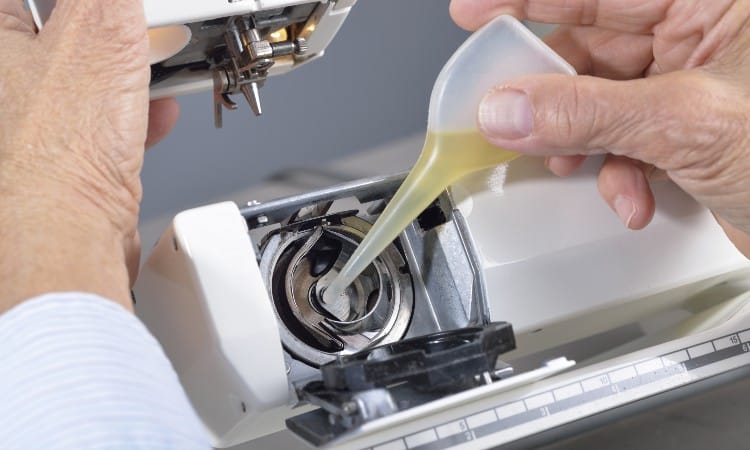
Because Bernina machines contain lots of moving metal parts, even the newer models may require careful oiling. How do you find out for sure if you need oil? Read your owner’s manual!
Every Bernina manual will give you a thorough cleaning and oiling guide to help keep your machine in tip-top shape. Some models may need special oiling in key areas, such as the hook race, so take your time and read this guide slowly!
The manual will also say this, but make sure you use only the appropriate sewing machine oil! Other types of oil will get gummy or damage your machine.
Bernina Sewing Machine Parts
It helps to know where to find parts for your Bernina sewing machine when you get into the nuts and bolts of troubleshooting!
You can look for Bernina sewing machine parts in several different ways. First, if your machine is still under warranty, reach out to your local Bernina dealer because you may get a free part or even a free part and a repair!
If you do have to order the part and install it yourself, you may still want to start with Bernina to make sure you get a quality, branded piece. Check out the Bernina website to start your search!
That said, if you have a vintage Bernina or can’t afford such high prices, you can also find an excellent variety of Bernina parts and accessories for sale on Etsy, eBay, or Amazon. Sewing stores often stock at least a few Bernina items as well, if you prefer in-person shopping!
Bernina Sewing Machine Repair Manual
Your Bernina sewing machine repair manual will explain all the moving parts and pieces of your machine, describe its various functions and show you how to clean and oil it. You should never try to use a sewing machine for the first time without reading the manual!
Fortunately, Bernina makes it very easy to get a replacement manual. Check out the Bernina Support website. All you have to do is plug in the make and model of your machine!
If you have an older or vintage manual, you may need to visit this page on Bernina’s website instead of hunting down an out-of-print manual.
How Much Does it Cost to Service a Bernina Sewing Machine?
The cost for a simple Bernina sewing machine tune-up is about $150, on average. Basic repairs such as a foot control repair may cost only $55, plus any parts needed. That said, the cost of getting your Bernina sewing machine serviced can vary a lot depending on many factors, such as the age of your machine. How quickly you need the repair done and the complexity of the problem also make a difference.
Other factors can play a role as well. If you have a warranty, Bernina will provide some services for free. Check the terms of your warranty or contact Bernina’s customer service to find out if this applies to you.
Most shops will charge based on the kind of repair, but some may charge by the hour instead. You should ask lots of questions before you bring your precious, expensive Bernina into a new shop!
You do want to make sure you take your machine to an authorized Bernina dealer or repair shop, though! These pros have a certification that proves they know exactly how to fix your machine.
Is My Sewing Machine Worth Fixing?
In almost every case, a Bernina sewing machine is well worth paying a few hundred dollars for a repair. Bernina machines have the kind of precision and durability you just don’t find elsewhere. Plus, many high-end models offer complex functions and cost a pretty huge amount of money.
It’s silly to throw away a multi-thousand-dollar machine because it needs a two or three-hundred-dollar repair!
Now, if you plan to upgrade to a newer model, you might want to consider passing on your cranky older machine instead of spending time and money repairing it. But most of the time, it’s well worth the effort to get even a vintage Bernina back up and running!
Bernina Service Center
Bernina makes it easy as pie to find a service center. All you have to do is go to the Bernina website and use the store locator provided on the screen!
Then you can call the nearest service center, find out what kinds of fees they charge, and set up an appointment!
While you can certainly just Google “Bernina repair shop,” going through the company website helps you narrow down your results to only those technicians who are authorized by Bernina.
Bernina Dealer Near Me
Often, Bernina service centers and dealers are the same things, but sometimes dealers may sell Bernina machines and not provide repairs. If you are in the market for a Bernina sewing machine, visit the company website to locate reputable, authorized Bernina dealers!
Once again, all you have to do is use the locate option provided on the website.
Discount Bernina Sewing Machines
If you do not need to have the cutting-edge, latest model Bernina has on the market, you can often find older Bernina models at a discount price. You can easily shop online for older or vintage models.
Some Bernina dealers will offer older models for lower prices. eBay and Etsy sometimes have very nice vintage models for sale.
Bernina models cost so much when new that even vintage models have a much higher than average price range! If you want a high-class Bernina model, even at a discount price, you may need to pay a thousand dollars or more.
On the bright side, older or vintage Bernina sewing machines often have many years of smooth sewing left in them, thanks to the excellent craftsmanship of this brand!
How Long Does a Bernina Sewing Machine Last?
There is no hard-and-fast rule for how long sewing machines of any brand will last, but it’s fair to say that Bernina sewing machines typically last far longer than other sewing machines that use cheap plastic parts. Some experts argue that the average computerized sewing machine lasts as little as five years to as much as twenty-five years, but Bernina’s computerized models at least claim to have an expected lifespan of fifty years!
As with any machine, though, the lifespan depends on the care given to the sewing machine. If you take care of your Bernina according to the directions in your manual and take it to an authorized technician when it needs repairs, you can expect it to keep running for decades!
Conclusion
Bernina sewing machines are built with durable parts and precise craftsmanship that keeps them running most of the time. But all sewing machines need basic maintenance and occasional troubleshooting from time to time! Bernina sewing machines may sometimes have tension issues, broken thread, and jammed needles or handwheels.
Many Bernina models do need careful oiling because they contain moving metal parts. All Bernina sewing machines need loose threads and lint removed regularly.
Do you have a Bernina sewing machine? What is the strangest problem you have ever had to troubleshoot in it? Leave a comment below to let us know!